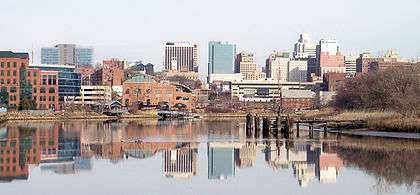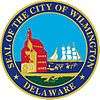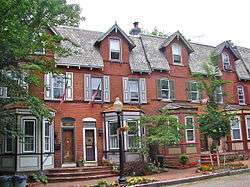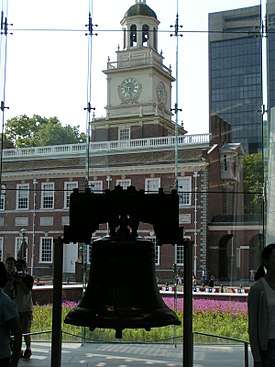Wilmington, Delaware
| Wilmington, Delaware | ||
|---|---|---|
| City | ||
|
Downtown Wilmington and the Christina River | ||
| ||
| Etymology: Named after Spencer Compton, Earl of Wilmington | ||
| Nickname(s): Corporate Capital of the World, Chemical Capital of the World | ||
| Motto: In the middle of it all[1] | ||
 Location of Wilmington in New Castle County, Delaware. | ||
 Wilmington  Wilmington Location within the state of Delaware | ||
| Coordinates: 39°44′45″N 75°32′48″W / 39.74583°N 75.54667°WCoordinates: 39°44′45″N 75°32′48″W / 39.74583°N 75.54667°W | ||
| Country | United States | |
| State | Delaware | |
| County | New Castle | |
| Founded | March 1638 | |
| Incorporated | 1731 | |
| Borough Charter | 1739 | |
| City Charter | March 7, 1832 | |
| Named for | Spencer Compton, 1st Earl of Wilmington | |
| Government | ||
| • Type | Council-mayor | |
| • Mayor | Mike Purzycki (D) | |
| Area[2] | ||
| • City | 16.94 sq mi (43.88 km2) | |
| • Land | 10.90 sq mi (28.24 km2) | |
| • Water | 6.04 sq mi (15.64 km2) | |
| Elevation | 92 ft (28 m) | |
| Population (2010) | ||
| • City | 70,851 | |
| • Estimate (2016)[3] | 71,442 | |
| • Rank | US: 483rd | |
| • Density | 6,551.91/sq mi (2,529.68/km2) | |
| • Metro | 6,069,875 (US: 7th)[4] | |
| Time zone | Eastern (EST) (UTC-5) | |
| • Summer (DST) | EDT (UTC-4) | |
| ZIP codes | 19801-19810, 19850, 19880, 19884-19886, 19890-19899 | |
| Area code(s) | 302 | |
| FIPS code | 10-77580 | |
| GNIS feature ID | 214862[5] | |
| Website | ci.wilmington.de.us | |
Wilmington (Lenape: Paxahakink, Pakehakink[6]) is the largest city in the state of Delaware, United States, built on the site of Fort Christina, the first Swedish settlement in North America. It is located at the confluence of the Christina River and Brandywine River, near where the Christina flows into the Delaware River. It is the county seat of New Castle County and one of the major cities in the Delaware Valley metropolitan area. Wilmington was named by Proprietor Thomas Penn after his friend Spencer Compton, Earl of Wilmington, who was prime minister in the reign of George II of Great Britain.
As of the 2015 United States Census estimate, the population of the city is 71,948, reflecting an increase of 1.5% from the 2010 Census.[7] The Wilmington Metropolitan Division, comprising New Castle County, DE, Cecil County, MD and Salem County, NJ, had an estimated 2015 population of 723,341.[8] And the Delaware Valley metropolitan area, which includes the cities of Philadelphia, Pennsylvania, and Camden, New Jersey, had a 2015 population of 6,069,875, and a combined statistical area of 7,183,479.[9][10]
History
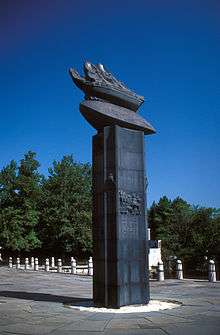
Wilmington is built on the site of Fort Christina and the settlement Kristinehamn,[11] the first Swedish settlement in North America.
The area now known as Wilmington was settled by the Lenape (or Delaware Indian) band led by Sachem (Chief) Mattahorn just before Henry Hudson sailed up the Len-api Hanna ("People Like Me River", present Delaware River) in 1609. The area was called "Maax-waas Unk" or "Bear Place" after the Maax-waas Hanna (Bear River) that flowed by (present Christina River). It was called the Bear River because it flowed west to the "Bear People", who are now known as the People of Conestoga or the Susquehannocks.
The Dutch heard and spelled the river and the place as "Minguannan." When settlers and traders from the Swedish South Company under Peter Minuit arrived in March 1638 on the Fogel Grip and Kalmar Nyckel, they purchased Maax-waas Unk from Chief Mattahorn and built Fort Christina at the mouth of the Maax-waas Hanna (which the Swedes renamed the Christina River after Queen Christina of Sweden). The area was also known as "The Rocks", and is located near the foot of present-day Seventh Street. Fort Christina served as the headquarters for the colony of New Sweden which consisted of, for the most part, the lower Delaware River region (parts of present-day Delaware, Pennsylvania, and New Jersey), but few colonists settled there.[12][13] Dr. Timothy Stidham (Swedish:Timen Lulofsson Stiddem) was a prominent citizen and doctor in Wilmington. He was born in 1610, probably in Hammel, Denmark and raised in Gothenburg, Sweden. He arrived in New Sweden in 1654 and is recorded as the first physician in Delaware.[14][15]
The most important Swedish governor was Colonel Johan Printz, who ruled the colony under Swedish law from 1643 to 1653. He was succeeded by Johan Rising, who upon his arrival in 1654, seized the Dutch post Fort Casimir, located at the site of the present town of New Castle, which was built by the Dutch in 1651. Rising governed New Sweden until the autumn of 1655, when a Dutch fleet under the command of Peter Stuyvesant subjugated the Swedish forts and established the authority of the Colony of New Netherland throughout the area formerly controlled by the Swedes. This marked the end of Swedish rule in North America.
Beginning in 1664 British colonization began; after a series of wars between the Dutch and English, the area stabilized under British rule, with strong influences from the Quaker communities under the auspices of Proprietor William Penn. A borough charter was granted in 1739 by King George II, which changed the name of the settlement from Willington, after Thomas Willing (the first developer of the land, who organized the area in a grid pattern similar to that of its northern neighbor Philadelphia),[16][17][18] to Wilmington, presumably after Spencer Compton, Earl of Wilmington.
Although during the American Revolutionary War only one small battle was fought in Delaware, British troops occupied Wilmington shortly after the nearby Battle of Brandywine on September 11, 1777. The British remained in the town until they vacated Philadelphia in 1778.
In 1800, Eleuthère Irénée du Pont, a French Huguenot, emigrated to the United States. Knowledgeable in the manufacture of gunpowder, by 1802 DuPont had begun making the explosive in a mill on the Brandywine River north of Brandywine Village and just outside the town of Wilmington.[19] The DuPont company became a major supplier to the U.S. military.[20] Located on the banks of the Brandywine River, the village was eventually annexed by Wilmington city.

The greatest growth in the city occurred during the Civil War. Delaware, though officially remaining a member of the Union, was a border state and divided in its support of both the Confederate and the Union causes. The war created enormous demand for goods and materials supplied by Wilmington including ships, railroad cars, gunpowder, shoes, and other war-related goods.
By 1868, Wilmington was producing more iron ships than the rest of the country combined and it rated first in the production of gunpowder and second in carriages and leather. Due to the prosperity Wilmington enjoyed during the war, city merchants and manufacturers expanded Wilmington's residential boundaries westward in the form of large homes along tree-lined streets. This movement was spurred by the first horsecar line, which was initiated in 1864 along Delaware Avenue.
.jpg)
The late 19th century saw the development of the city's first comprehensive park system. William Poole Bancroft, a successful Wilmington businessman influenced by the work of Frederick Law Olmsted, led the effort to establish open parkland in Wilmington. Rockford Park and Brandywine Park were created due to Bancroft's efforts.
Both World Wars stimulated the city's industries. Industries vital to the war effort – shipyards, steel foundries, machinery, and chemical producers – operated around the clock. Other industries produced such goods as automobiles, leather products, and clothing.
The post-war prosperity again pushed residential development further out of the city. In the 1950s, more people began living in the suburbs of North Wilmington and commuting into the city to work. This was made possible by extensive upgrades to area roads and highways and through the construction of Interstate 95, which cut through several of Wilmington's neighborhoods and accelerated the city's population decline. Urban renewal projects in the 1950s and 1960s cleared entire blocks of housing in the Center City and East Side areas.
Riots and civil unrest in the city followed the 1968 assassination of Rev. Martin Luther King, Jr. On April 9, 1968, Governor Charles L. Terry, Jr. deployed the National Guard and the Delaware State Police to the city at the request of Mayor John Babiarz. Babiarz asked Terry to withdraw the National Guard the following week, but the governor kept them in the city until his term ended in January 1969. This is reportedly the longest occupation of an American city by state forces in the nation's history.[21]
In the 1980s, job growth and office construction were spurred by the arrival of national banks and financial institutions in the wake of the 1981 Financial Center Development Act, which liberalized the laws governing banks operating within the state, and similar laws in 1986. Today, many national and international banks, including Bank of America, Capital One, Chase, and Barclays, have operations in the city, typically credit card operations.
Geography
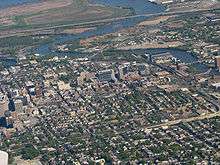
According to the United States Census Bureau, the city has a total area of 17.0 square miles (44 km2). Of that, 10.9 square miles (28 km2) is land and 6.2 square miles (16 km2) is water. The total area is 36.25% water.
The city sits at the confluence of the Christina River and the Delaware River, about 33 miles (53 km) southwest of Philadelphia. Wilmington Train Station, one of the southernmost stops on Philadelphia's SEPTA rail transportation system, is also served by Northeast Corridor Amtrak passenger trains. Wilmington is served by I-95 and I-495 within city limits. In addition, the twin-span Delaware Memorial Bridge, a few miles south of the city, provides direct highway access between Delaware and New Jersey, carrying the I-295 eastern bypass route around Wilmington and Philadelphia, as well as US 40, which continues eastward to Atlantic City, New Jersey.

These transportation links and geographic proximity give Wilmington some of the characteristics of a satellite city to Philadelphia, but Wilmington's long history as Delaware's principal city, its urban core, and its independent value as a business destination makes it more properly considered a small but independent city in the Philadelphia metropolitan area.
Wilmington lies along the Fall Line geological transition from the Mid-Atlantic Piedmont Plateau to the Atlantic Coastal Plain. East of Market Street, and along both sides of the Christina River, the Coastal Plain land is flat, low-lying, and in places marshy. The Delaware River here is an estuary at sea level (with twice-daily high and low tides), providing sea-level access for ocean-going ships.
On the western side of Market Street, the Piedmont topography is rocky and hilly, rising to a point that marks the watershed between the Brandywine River and the Christina River. This watershed line runs along Delaware Avenue westward from 10th Street and Market Street.
These contrasting topography and soil conditions affected the industrial and residential development patterns within the city. The hilly west side was more attractive for the original residential areas, offering springs and sites for mills, better air quality, and fewer mosquitoes.
Surrounding municipalities
| Adjacent places of Wilmington, Delaware | ||||
|---|---|---|---|---|
 |
Greenville, Delaware | Talleyville, Delaware | Bellefonte, Delaware |  |
| Elsmere, Delaware | |
Penns Grove, New Jersey | ||
| ||||
| | ||||
| Newport, Delaware | New Castle, Delaware | Pennsville, New Jersey | ||
Climate
Wilmington has a warm temperate climate or humid subtropical climate (Köppen Cfa), with hot and humid summers, cool to cold winters, and precipitation evenly spread throughout the year. In July, the daily average is 76.8 °F (24.9 °C), with an average 21 days of 90 °F (32 °C)+ highs annually. Summer thunderstorms are common in the hottest months. The January daily average is 32.4 °F (0.2 °C), although temperatures may occasionally reach 10 °F (−12 °C) or 55 °F (13 °C) as fronts move toward and past the area. Snowfall is light to moderate, and variable, with some winters bringing very little of it and others witnessing several major snowstorms; the average seasonal total is 20.2 inches (51 cm). Extremes in temperature have ranged from −15 °F (−26 °C) on February 9, 1934, up to 107 °F (42 °C) on August 7, 1918, though both 100 °F (38 °C)+ and 0 °F (−18 °C) readings are uncommon; the last occurrence of each was July 18, 2012 and February 5, 1996, respectively.
| Climate data for Wilmington, Delaware (New Castle County Airport), 1981–2010 normals, extremes 1894–present | |||||||||||||
|---|---|---|---|---|---|---|---|---|---|---|---|---|---|
| Month | Jan | Feb | Mar | Apr | May | Jun | Jul | Aug | Sep | Oct | Nov | Dec | Year |
| Record high °F (°C) | 75 (24) |
78 (26) |
86 (30) |
97 (36) |
98 (37) |
102 (39) |
103 (39) |
107 (42) |
100 (38) |
94 (34) |
85 (29) |
75 (24) |
107 (42) |
| Mean maximum °F (°C) | 61.2 (16.2) |
63.1 (17.3) |
73.7 (23.2) |
82.6 (28.1) |
88.3 (31.3) |
93.2 (34) |
96.0 (35.6) |
93.7 (34.3) |
89.1 (31.7) |
81.6 (27.6) |
72.5 (22.5) |
63.9 (17.7) |
96.9 (36.1) |
| Average high °F (°C) | 40.2 (4.6) |
43.5 (6.4) |
52.4 (11.3) |
63.5 (17.5) |
73.0 (22.8) |
81.8 (27.7) |
86.1 (30.1) |
84.2 (29) |
77.4 (25.2) |
66.2 (19) |
55.7 (13.2) |
44.6 (7) |
64.1 (17.8) |
| Average low °F (°C) | 24.6 (−4.1) |
26.8 (−2.9) |
33.6 (0.9) |
43.0 (6.1) |
52.6 (11.4) |
62.6 (17) |
67.6 (19.8) |
66.1 (18.9) |
58.2 (14.6) |
46.1 (7.8) |
37.4 (3) |
28.7 (−1.8) |
45.6 (7.6) |
| Mean minimum °F (°C) | 7.4 (−13.7) |
11.6 (−11.3) |
17.9 (−7.8) |
29.7 (−1.3) |
38.7 (3.7) |
49.9 (9.9) |
56.7 (13.7) |
54.3 (12.4) |
43.7 (6.5) |
32.8 (0.4) |
23.3 (−4.8) |
13.6 (−10.2) |
4.3 (−15.4) |
| Record low °F (°C) | −14 (−26) |
−15 (−26) |
2 (−17) |
11 (−12) |
30 (−1) |
40 (4) |
48.3 (9.1) |
43 (6) |
32 (0) |
23 (−5) |
11 (−12) |
−7 (−22) |
−15 (−26) |
| Average precipitation inches (mm) | 3.01 (76.5) |
2.68 (68.1) |
3.92 (99.6) |
3.50 (88.9) |
3.95 (100.3) |
3.88 (98.6) |
4.57 (116.1) |
3.25 (82.6) |
4.32 (109.7) |
3.42 (86.9) |
3.10 (78.7) |
3.48 (88.4) |
43.08 (1,094.2) |
| Average snowfall inches (cm) | 5.9 (15) |
8.3 (21.1) |
1.9 (4.8) |
0.3 (0.8) |
0 (0) |
0 (0) |
0 (0) |
0 (0) |
0 (0) |
0 (0) |
0.4 (1) |
3.4 (8.6) |
20.2 (51.3) |
| Average precipitation days (≥ 0.01 in) | 10.5 | 9.4 | 10.7 | 11.3 | 11.2 | 10.3 | 9.9 | 8.1 | 8.5 | 8.3 | 9.2 | 10.3 | 117.7 |
| Average snowy days (≥ 0.1 in) | 4.3 | 3.6 | 1.3 | 0.4 | 0 | 0 | 0 | 0 | 0 | 0 | 0.2 | 2.0 | 11.8 |
| Source: NOAA[22][23] | |||||||||||||
Demographics
| Historical population | |||
|---|---|---|---|
| Census | Pop. | %± | |
| 1820 | 5,268 | — | |
| 1830 | 6,628 | 25.8% | |
| 1840 | 8,367 | 26.2% | |
| 1850 | 13,979 | 67.1% | |
| 1860 | 21,258 | 52.1% | |
| 1870 | 30,841 | 45.1% | |
| 1880 | 42,478 | 37.7% | |
| 1890 | 61,431 | 44.6% | |
| 1900 | 76,508 | 24.5% | |
| 1910 | 87,411 | 14.3% | |
| 1920 | 110,168 | 26.0% | |
| 1930 | 106,597 | −3.2% | |
| 1940 | 112,504 | 5.5% | |
| 1950 | 110,356 | −1.9% | |
| 1960 | 95,827 | −13.2% | |
| 1970 | 80,386 | −16.1% | |
| 1980 | 70,195 | −12.7% | |
| 1990 | 71,529 | 1.9% | |
| 2000 | 72,664 | 1.6% | |
| 2010 | 70,851 | −2.5% | |
| Est. 2016 | 71,442 | [3] | 0.8% |
| U.S. Decennial Census[24] 2015 Estimate[25] | |||
As of the census of 2010, there were 70,851 people, 28,615 households, and 15,398 families residing in the city. The population density was 6,497.6 per square mile (2,508.8/km²). There were 32,820 housing units at an average density of 3,009.9 per square mile (1,162.1/km²) and with an occupancy rate of 87.2%. The racial makeup of the city was 58.0% African American, 32.6% White, 0.4% Native American, 1.0% Asian, <0.1% Pacific Islander, 5.4% from other races, and 2.6% from two or more races. 12.4% of the population were Hispanic or Latino of any race. Non-Hispanic Whites were 27.9% of the population in 2010,[26] compared to 40.5% in 1990.[27] As of the census of 2000, the largest ancestries included: Irish (8.7%), Italian (5.7%), German (5.2%), English (4.4%), and Polish (3.6%).[28]
There were 28,615 households out of which 25.0% had children under the age of 18 living with them, 23.5% were married couples living together, 24.8% had a female householder with no husband present, 5.6% had a male householder with no wife present, and 46.2% were non-families. 38.1% of all households were made up of individuals and 12.3% had someone living alone who was 65 years of age or older. The average household size was 2.36 and the average family size was 3.18.
In the city, the age distribution of the population shows 24.4% under the age of 18, 10.0% from 18 to 24, 29.8% from 25 to 44, 24.2% from 45 to 64, and 11.6% who were 65 years of age or older. The median age was 34.3 years. For every 100 females there were 90.5 males. For every 100 females age 18 and over, there were 87.4 males.
According to ACS 1-year estimates for 2010, the median income for a household in the city was $32,884, and the median income for a family was $37,352. Males working full-time had a median income of $41,878 versus $36,587 for females working full-time. The per capita income for the city was $24,861. 27.6% of the population and 24.9% of families were below the poverty line. 45.7% of those under the age of 18 and 16.5% of those 65 and older were living below the poverty line.[29]
Government
The Wilmington City Council consists of thirteen members. The council consists of eight members who are elected from geographic districts, four elected at-large and the City Council President. The Council President is elected by the entire city. The Mayor of Wilmington is also elected by the entire city.
The current mayor of Wilmington is Mike Purzycki (D).[30]
| District | Councilperson | Party | - |
|---|---|---|---|
| President | Hanifa Shabazz | Democratic | 2017 |
| Treasurer | Velda Jones-Potter | Democratic | 2017 |
| 1 | Nnamdi Chukwuocha | Democratic | 2017 |
| 2 | Ernest "Trippi" Congo II | Democratic | 2017 |
| 3 | Zanthia Oliver | Democratic | 2017 |
| 4 | Michelle Harlee | Democratic | 2017 |
| 5 | Vashun Turner | Democratic | 2017 |
| 6 | Yolanda McCoy | Democratic | 2017 |
| 7 | Robert Williams | Democratic | 2017 |
| 8 | Bud Freel | Democratic | 2017 |
| At-Large | Rysheema Dixon | Democratic | 2017 |
| Sam Guy | Democratic | 2017 | |
| Ciro Adams | Republican | 2017 | |
The Delaware Department of Correction Howard R. Young Correctional Institution, renamed from Multi-Purpose Criminal Justice Facility in 2004 and housing both pretrial and posttrial male prisoners, is located in Wilmington. The prison is often referred to as the "Gander Hill Prison" after the neighborhood it is located in. The prison opened in 1982.[31]
Many Wilmington City workers belong to one of several Locals of the American Federation of State, County and Municipal Employees union.[32]
Neighborhoods
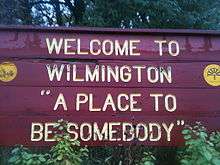
The city of Wilmington is made up of the following neighborhoods:[33]
North of the Brandywine River
- Baynard Village
- Brandywine Hills – This neighborhood of approximately 225 homes in northern Wilmington was started in the 1930s. The streets in the neighborhood are named after famous American and English authors, including Byron, Emerson, Hawthorne and Milton. It is bounded by Lea Boulevard, Rockwood Road, Miller Road, and Market Street[34]
- Brandywine Village[35]
- Eastlawn
- Eastlake
- Gander Hill (Lower Brandywine Village)
- Harlan
- Ninth Ward – Originally a post-Civil War political creation, the city's Ninth Ward has long been an area with owner-occupied residences. The Ninth Ward was integrated as a result of population shifts in the 1960s and remains a stable, working-class neighborhood.
- Prices Run
- Riverside – Is a housing development in the northeastern corner of the city. It was built in 1959.
- Triangle – a group of homes built in the 1920s whose corresponding streets along I-95 and Baynard Boulevard and 18th Street and Concord Avenue loosely form a triangle.[36] It is bounded by W 18th St, Baynard Boulevard, Concord Ave, and Broom St.
East of I-95
- Center City (Downtown)
- East Side –
- Justison Landing
- LOMA
- Midtown Brandywine – Located on the banks of the Brandywine River, Midtown Brandywine is bordered by North Washington Street, East 11th Street, North French Street and South Park Drive. Homes in the neighborhood were first established in the late 1800s as the Brandywine River became home to several mills and trading posts. Midtown Brandywine's boundaries include the Brandywine Park, Fletcher Brown Park, the Hercules building, a neighborhood adopted pocket park, and several notable restaurants and eateries. The neighborhood is also home to "The Little Church", previously known as The Old Presbyterian Church. Originally built on Market Street between 9th and 10th streets, the gambrel-roofed church was relocated to its current site on South Park Drive in 1917 and has since become synonymous with Midtown Brandywine.[37]
- Quaker Hill[38] – From a country hilltop in the 19th century to rows of city homes today, Quaker Hill (which surrounds the historical Quaker Friends Meeting House) has watched its neighborhood become much more modernized over the last three centuries. This city district was founded by Quakers William Shipley and Thomas West in the early 18th century. The nearby Meeting House keeps Quaker Hill closely tied to its rich history. The cemetery of the Wilmington Friends House is the burial site of the abolitionist Thomas Garrett and John Dickinson, signer of the U.S. Constitution.[39]
- Riverfront[40] – Formerly a hub for manufacturing and the city's shipbuilding industry, which began to see a rapid series of state-sponsored urban renewal and gentrification projects beginning in the late 1990s. The neighborhood is currently home to landmarks such as the Wilmington Blue Rocks' Baseball Stadium and the Shipyard Shops.
- Southbridge
- Trinity Vicinity – This neighborhood is located in the center of Wilmington, next to the Trinity Church and Interstate 95. A collection of row homes and detached houses, many of which were originally built in the late 19th century. The revitalization of the neighborhood was aided by the Urban Homesteading Act in the 1970s. The neighborhood was designated as a historic district in the 1990s.[41]
- Upper East Side (East Brandywine)
- West Center City
- 11th St. Bridge[42]
West of I-95
- Bayard Square
- Browntown – areas in the city that were originally populated by Polish immigrants. Today, the Polish community maintains a strong presence, while other ethnicities have moved in the neighborhood's borders.[43]
- Canby Park
- Cool Spring & Tilton Park – bounded loosely by Pennsylvania Avenue on the north, West 7th Street on the south, North Jackson Street on the east and North Rodney Street on the west. The neighborhood is home to two Catholic schools, Ursuline Academy[44] and Padua Academy.[45] The neighborhood is also the location of the private University & Whist Club and the Holy Trinity Greek Orthodox Church, which hosts an annual Greek cultural festival.[46]
- Delaware Avenue
- The Flats – The Flats was founded by businessman William Bancroft who developed the neighborhood in 1901 under the Woodlawn Company, now known as the Woodlawn Trustees, with the intention of creating affordable homes for working class residents of Wilmington. The predominantly minority community is currently in the process of gaining authorization for a $100 million revitalization to be performed in seven phases over 12 years.[47]
- Forty Acres – This historically Irish neighborhood, rural until the mid-19th century, developed from the farmland of Joshua T. Heald. One of the city's first suburbs, the neighborhood is centered on the St. Ann's Roman Catholic Church. The name Forty Acres is taken from the fertility of the farmland. One acre of the land was said to be worth 40 acres (160,000 m2) one might find someplace else. The neighborhood exists northeast of Delaware Avenue, southwest of Riddle Avenue, east of Union Street and west of DuPont Street, with Lovering Avenue as its eastern boundary.[48]
- Greenhill
- Happy Valley – a small collection of late 19th-century row houses on the southeastern slope to Brandywine Park, between Adams Street, Van Buren Street (I-95), Wawaset Street and Gilpin Avenue.
- Hedgeville
- The Highlands – located between Pennsylvania Avenue and Delaware Avenue, the Highlands neighborhood, centered on 18th Street southeast of Rockford Park, was developed by Joshua Heald in the 19th century for affluent, middle-class residents. It contains detached and semi-detached houses of exuberant architectural detailing, representing numerous popular styles of the time.
- Hilltop – This area located along 4th Street and roughly bordered by Lancaster Avenue, Jackson Street, Clayton Street has remained one of the most diverse neighborhoods in the city since the late 19th century. Today, this area is home to one of the city's fastest growing segments – the Hispanic community.[49]
- Little Italy – this neighborhood consists of the area around Union Street and Lincoln streets, between Pennsylvania Avenue and Lancaster Avenue. Anchored by the immigration waves of the late 19th century and early 20th century, Little Italy has retained its roots, even as neighborhood remodeling projects update the scenery. A central feature of the neighborhood is the St. Anthony's of Padua Roman Catholic Church. The neighborhood hosts an annual Italian Festival in the summertime.[50]
- St. Elizabeth Area – The St. Elizabeth area is anchored by the St. Elizabeth Parish at 809 S. Broom St., considered the heart of the Catholic community. This historic church, built on the grounds of the Banning Estate, dates back to 1908.
- Trolley Square – settled in the 1860s after the city's trolley line had extended into farmland once owned by the Shallcross and Lovering families. The city's former trolley depot and bus barn was located on the spot where the Trolley Square shopping complex now sits. The neighborhood lies between Harrison Street, Pennsylvania Avenue, Lovering Avenue and the B&O Railroad track.[51]
- Wawaset
- Wawaset Heights
- Wawaset Park – The neighborhood was constructed by the Dupont Company in 1918 to provide a residential community for their employees. Baltimore architect Edward L. Palmer, Jr. was chosen to design the community, which was to have a mix of single family homes and smaller attached Prior to the development of houses. The neighborhood was constructed on a 50-acre (200,000 m2) plot. Prior to its construction, the tract of land had been used as a horse racing track and a fairground. Wawaset Park was placed on the Register of Historic Places in 1986. The neighborhood is bounded by Pennsylvania Avenue, West 7th Street, Woodlawn Avenue and Greenhill Avenue.[52]
- West Hill
- Westmoreland – detached housing developed in the 1950s, as part of the suburban movement that followed the end of World War II. Its location is adjacent to the original Wilmington Country Club, bounded by Ogle Avenue, Dupont Road, the Wilmington High School property and the Ed "Porky" Oliver Golf Course.
- Union Park Gardens[53]
Historic districts
The City of Wilmington designates nine areas as historic districts: the Baynard Boulevard, Kentmere Parkway, Rockford Park, Cool Spring/Tilton Park, the tri-part sections of the Eastside, St. Marys and Old Swedes Church, Quaker Hill, Delaware Avenue, Trinity Vicinity, and Upper/Lower Market Street.[54]
Gallery
 The Brandywine Academy building
The Brandywine Academy building- Friends Meeting House in Quaker Hill
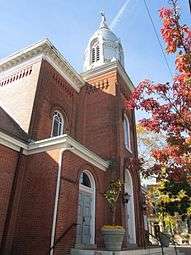 Cathedral of Saint Peter in Quaker Hill
Cathedral of Saint Peter in Quaker Hill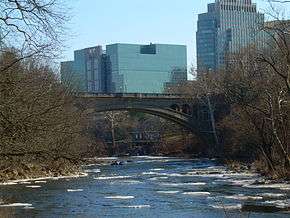 Brandywine Creek in Brandywine Park near downtown Wilmington in February 2007, looking downstream toward Washington Street Bridge
Brandywine Creek in Brandywine Park near downtown Wilmington in February 2007, looking downstream toward Washington Street Bridge
Public safety
Crime
| Wilmington | |
|---|---|
| Crime rates* (2014) | |
| Violent crimes | |
| Homicide | 27 |
| Robbery | 397 |
| Aggravated assault | 727 |
| Total violent crime | 1,174 |
| Property crimes | |
| Burglary | 900 |
| Larceny-theft | 2,530 |
| Motor vehicle theft | 335 |
| Arson | 2 |
| Total property crime | 3,765 |
|
Notes *Number of reported crimes per 100,000 population. 2014 population: 71,713
| |
In 2010, Wilmington had 27 homicides, breaking the two-year-old record of 26.[55] In 2011, community mobilization against crime was reported to be on the rise in the city.[56]
In 2012, Parenting magazine called Wilmington the nation's most dangerous city on a per capita basis.[57]
In 2013, Wilmington saw 150 shootings by December 12, breaking a three-year-old record of 142.[58]
Between 2003 and 2012, an average of 560 vehicles were stolen in Wilmington each year.[59]
In March 2014, Movoto Real Estate rated Wilmington the most dangerous small city in the country.[60]
In December 2014, Newsweek called it "Murder Town USA."[61]
Police
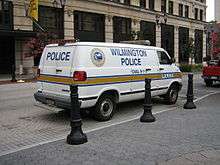
The Wilmington Police Department (WPD), which aims to "raise the level of public safety through law enforcement and thereby reduce the fear and incidence of crime", is authorized to deploy up to 289 officers in motor vehicles, on foot, and on bicycle. Its operations are accredited by the Commission on Accreditation for Law Enforcement Agencies. As of 2017, its chief is Robert Tracy.[62]
In 2002, the Police Department started a program known as jump-outs in which unmarked police vans would patrol crime-prone neighborhoods late at night, suddenly converge at street corners and temporarily detain loiterers; photographing and fingerprinting the detainees. The program was touted as a good way to arrest people with drugs or weapons, fill out the police's database of fingerprints, and identify eyewitnesses for future crime investigations. Some citizens said the practice violated civil rights.[63]
Also in 2002, Wilmington became perhaps the first U.S. city with surveillance cameras covering the downtown area.[64]
Fire department and EMS
The Wilmington Fire Department (WFD) is led by Chief Anthony S. Goode and maintains five engine companies, two ladder companies, a squad company, and a marine fire fighting force. The department has a ridealong program to help recruit new firefighters. It requires firefighters to be regularly involved with community associations. Wilmington is the only municipality in Delaware with an all-career fire department.
Emergency medical services are provided through contract with the city's St. Francis Hospital, whose EMS division operates a minimum five BLS transport units at all times of the day. Advanced Life Support services in the City of Wilmington are provided by New Castle County's EMS Division with two city-based medic units. All Wilmington firefighters since 2002 are trained to the EMT-B level and serve as first responders for life-threatening emergencies.
On July 1, 2009, the national financial crisis and projected city budget shortfall led the department to lay off firefighters for the first time in city history. Eight of the department's 173 uniformed personnel were laid off, but returned to work within 13 months to replace retiring personnel. The department also launched began a rolling by-pass of three engine companies (Engine 5, Squirt 4, and Engine 6). Later, the city eliminated its only heavy rescue company, Rescue 1; its personnel were deployed to other companies. In order to provide technical rescue services, the department converted two engine companies into squad companies. Engine 1 was re-designated as Squad 1, Engine 3 re-designated as Squad 3. Rescue 1's heavy rescue vehicle remained equipped and held in reserve. Even with the elimination of Rescue 1, the Department continued the rolling by-pass of an engine company. The rolling by-pass now affected Squirt 4, Engine 5, and Engine 6. The Department found some financial relief in 2011 when it was awarded the federal SAFER grant. This enabled the department to fund 13 positions returning the department's staffing to 173 uniformed personnel.
Public health
Christiana Care Health System, a health network headquartered in Wilmington, runs Wilmington Hospital on the edge of downtown Wilmington and Christiana Hospital in suburban Christiana, as well as various satellite health centers throughout the area. St. Francis Hospital, a member of CHE Trinity Health, is located in the west end of Wilmington. The Nemours Foundation runs the A.I. duPont Hospital for Children in North Wilmington, just outside the city proper.
The city has one of the highest per capita rates of HIV infection in the United States, with disproportionate rates of infection among African-American males.[65][66] Efforts by local advocates to create needle exchange programs to reduce the spread of infection were obstructed for several years by downstate and suburban state legislators but a program was finally approved in June 2006.[67]
Economy
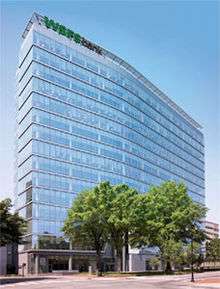
Much of Wilmington's economy is based on its status as the most populous and readily accessible city in Delaware, a state that made itself attractive to corporations with business-friendly financial laws and a longstanding reputation for a fair and effective judicial system. Contributing to the economic health of the downtown and Wilmington Riverfront regions has been the presence of Wilmington Station, through which 665,000 people passed in 2009.[68]
Wilmington has become a national financial center for the credit card industry, largely due to regulations enacted by former Governor Pierre S. du Pont, IV in 1981. The Financial Center Development Act of 1981, among other things, eliminated the usury laws enacted by most states, thereby removing the cap on interest rates that banks may legally charge customers. Many major credit card issuers, including Bank of America (formerly MBNA Corporation), Chase Card Services (part of JPMorgan Chase & Co., formerly Bank One/First USA), and Barclays Bank of Delaware (formerly Juniper Bank), are headquartered in Wilmington. The Dutch banking giant ING Groep N.V. headquartered its U.S. internet banking unit, ING Direct (now Capital One 360), in Wilmington. The United Kingdom's HSBC has their American operations headquartered in Wilmington. Wilmington Trust is headquartered in Wilmington at Rodney Square. Barclays and Capital One 360 have very large and prominent locations located along the waterfront of the Christina River. In 1988, the Delaware legislature enacted a law which required a would-be acquirer to capture 85 percent of a Delaware chartered corporation's stock in a single transaction or wait three years before proceeding. This law strengthened Delaware's position as a safe haven for corporate charters during an especially turbulent time filled with hostile takeovers.
Wilmington's other notable industries include insurance (American Life Insurance Company [ALICO], Blue Cross and Blue Shield of Delaware), retail banking (including the Delaware headquarters of: Wilmington Trust (Now a branch of M&T Bank, after Wilmington Trust merged with M&T in 2011), PNC Bank, Wachovia Bank, JPMorgan Chase, HSBC, Citizens Bank, Wilmington Savings Fund Society, and Artisans' Bank), and legal services. A General Motors plant was closed in 2009.[69] Wilmington is home to one Fortune 500 company, E.I. du Pont de Nemours and Company.[70] In addition, the city is the corporate domicile of more than 50% of the publicly traded companies in the United States, and over 60% of the Fortune 500.
Delaware chartered corporations rely on the state's Court of Chancery to decide legal disputes, which places legal decisions with a judge instead of a jury. The Court of Chancery, known both nationally and internationally for its speed, competence, and knowledgeable judiciary as a court of equity,[71] is empowered to grant broad relief in the form of injunctions and restraining orders, which is of particular importance when shareholders seek to block or enjoin corporate actions such as mergers or acquisitions. The Court of Chancery, as a statewide court, may hear cases in any of the state's three counties. A dedicated-use Chancery courthouse was constructed in 2003 in Georgetown, Sussex County.[72] It has hosted high-profile complex corporate trials such as the Disney shareholder litigation.
Because Delaware is the official state of incorporation for so many American companies, the United States Bankruptcy Court for the District of Delaware, located in Wilmington, is one of the busiest of the 94 federal bankruptcy courts located around the U.S.
Delaware has among the strictest rules in America regarding out-of-state legal practice, allowing no reciprocity to lawyers who passed the bar in other states.[73]
Top employers
According to Wilmington's 2015 Comprehensive Annual Financial Report,[74] the top employers in the city are:
| # | Employer | # of Employees |
|---|---|---|
| 1 | State of Delaware | 13,000 |
| 2 | Christiana Care Health System | 10,400 |
| 3 | DuPont | 8,100 |
| 4 | Bank of America | 7,100 |
| 5 | Walmart | 4,700 |
| 6 | AstraZeneca, Inc. | 4,500 |
| 7 | University of Delaware | 4,000 |
| 8 | A.I. Dupont Institute | 2,821 |
| 9 | Christina School District | 2,300 |
| 10 | The Y of Delaware | 2,300 |
| 11 | Citibank Delaware | 2,000 |
| 12 | Red Clay School District | 1,750 |
| 13 | M&T Bank | 1,700 |
| 14 | Walgreens | 1,700 |
| 15 | Siemens | 1,630 |
| 16 | Delaware Park | 1,550 |
| 17 | Brandywine School District | 1,450 |
| 18 | Comcast | 1,450 |
| 19 | Delmarva Power | 1,438 |
| 20 | Amtrak | 1,400 |
| 21 | Colonial School District | 1,271 |
| 22 | New Castle County Government | 1,250 |
| 23 | St. Francis Hospital | 1,200 |
| 24 | ING Direct (Capital One) | 1,122 |
| 25 | PNC Financial Services Group | 1,100 |
Departing from earlier practices, the 2014 Comprehensive Annual Report that is currently available declined to identify the city's top employers.[75] It is possible this information will be included, consistent with past reports, when a final version of the report is publicized as mandated by City Charter.[76]
Arts and culture
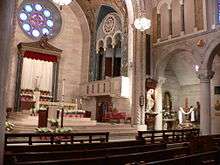
Wilmington has many museums, galleries, and gardens to enjoy (see Points of Interest below), as well as many ethnic festivals and other events throughout the year. Notable among its museums is the Delaware Art Museum whose collection focuses on American art and illustration from the 19th to the 21st century, and on the English Pre-Raphaelite movement of the mid-19th century.
Ethnic festivals
Wilmington has an active and diverse ethnic population, which contributes to several ethnic festivals held every spring and summer in Wilmington, the most popular of which is the Italian Festival. This event, run by St. Anthony of Padua Catholic Church, closes down six blocks in the west side of the city the second week of June for traditional Italian music, food, and activities, along with carnival rides and games. Another, somewhat smaller festival that draws large crowds is the Greek Festival, which is organized by Holy Trinity Greek Orthodox Church. The event features traditional Greek (Hellenic) crafts, food, drink, and music. Another notable annual festival is the Polish festival organized by St. Hedwig's Catholic Church, which features Polish cuisine with carnival rides and entertainment. Haneef's African Festival celebrates the heritage of the African American majority in the city.[77] Wilmington is also home to the annual Big August Quarterly, which since 1814 has celebrated African American religious freedom. IndiaFest, another cultural festival, is hosted by the Indo American Association of Delaware.[78] Wilmington also celebrates Hispanic Week, which coincides with National Hispanic Month festivities, September 15 – October 15. The festival culminates with a pageant and desfile (parade) along 4th Street. Concerts featuring Latin music acts, Latin cuisine and a carnival are held on the Riverfront on the last weekend. Activities are also held at St. Paul's Catholic Church.
Music festivals
The Clifford Brown Jazz Festival is a week-long outdoor music festival held each summer in Wilmington's Rodney Square.
The Peoples' Festival is an annual tribute to Bob Marley, who once lived in Wilmington trying to earn money enough to establish his Tuff Gong music studio in Kingston, Jamaica. His son Stephen Marley is born in Wilmington 1972. Started in 1994, the Peoples' Festival features reggae and world beat musicians playing original music and Bob Marley and the Wailers songs. The festival is held on the Wilmington riverfront each summer.
The Riverfront Blues Festival, a 3-day music festival held each August in the Tubman-Garrett Riverfront Park, features prominent blues acts as well as artists from the local area.
Holiday events
- Annual tree-lighting ceremony related to the Christmas holiday at Rockwood Museum and Park[79] The Nutcracker performed by the Wilmington Ballet at the Playhouse at the Hotel DuPont.
Wilmington Riverfront
In the 1990s, the city launched a campaign to revitalize the former shipyard area known as the Wilmington Riverfront. Delaware Theatre Company was at the forefront of this movement, opening its current space on Water Street in 1985.[80] The efforts were bolstered early by The Big Kahuna also known as Kahunaville (a restaurant, bar and arcade which has also since closed and been rebuilt in 2010 as the Delaware Children's Museum) and the Wilmington Blue Rocks minor league baseball stadium. The Wilmington Rowing Center boathouse is located along the Christina River on the Riverfront. Development continues as the Wilmington Riverfront tries to establish its cultural, economical, and residential importance. Recent high-rise luxury apartment buildings along the Christina River have been cited as evidence of the Riverfront's continued revival. On June 7, 2006, the groundbreaking of Justison Landing signaled the beginning of Wilmington's largest residential project since Bancroft Park was built after World War II. Outlets shops, restaurants and a Riverfront Market have also opened along the 1.2-mile (1.9 km) Riverwalk.
Media
Radio and television
The Wilmington area is home to five FM radio stations and four AM radio stations. A sixth FM radio station is located in Southern New Jersey and is included in the Wilmington radio market surveys:
- 91.3-FM WVUD—Non-commercial radio (University of Delaware, Newark, Delaware)
- 91.7-FM WMPH—Non-commercial high school radio
- 93.7-FM WSTW-- Pop contemporary hits
- 96.9-FM W245CJ - Hispanic format
- 99.5-FM WJBR-FM-- Adult contemporary
- 101.7-FM WDEL-FM- News Talk Information (Canton, New Jersey)
- 103.7-FM WXCY – Country
- 1150-AM WDEL—News Talk Information
- 1290-AM WWTX-- Sports talk
- 1380-AM WTMC—Travel Information
- 1450-AM WILM—News Talk Information
- Wilmington is part of the Philadelphia television market. Three of the market's stations are licensed to Wilmington--WTSD-CA, WPPX, WHYY-TV.
Newspaper
- The News Journal, founded as the Delaware Gazette in 1785. Daily circulation as of 2004 and 2007 exceeded 100,000, placing the newspaper among the top 100 in the United States based on circulation.[81][82]
- Wilmington Sunday Star (between 1881 – 1954)[83]
Portrayal of Wilmington in popular culture
- Wilmington's skyline and other aerial shots of the city stood in for the fictional town of Arcadia in the television program Joan of Arcadia.[84]
- The 1999 film Fight Club (adapted from Chuck Palahniuk's novel of the same title) is set in Wilmington. City officials rejected the filmmakers' request to film in Delaware, so the movie's exterior shots were filmed in Los Angeles.
- In the movie The Wrestler, the character portrayed by Mickey Rourke has his final match in Wilmington.
- In The Simpsons episode "Simpsons Tall Tales", the family wins a trip to Delaware and Lisa exclaims "I want to see Wilmington!"
- In the James Patterson novel Cat and Mouse, one of the crimes takes place in Wilmington.
- Episodes of various television crime procedurals, including Criminal Minds ("What Fresh Hell") and Bones ("Hole in the Heart") have been set in the city.
- In episode 4 of season 1 of the 1970s TV series The Incredible Hulk, called "The Final Round", David Banner comes to Wilmington, gets mugged, and befriends a boxer who is unknowingly running heroin for a mob boss.
- Saturday Night Live (SNL) skits portraying Vice President Joe Biden often mention his residency in Wilmington. For example, in the cold opening of the May 12, 2012, episode, Biden pouts in his Washington, D.C., bedroom, which features an aerial picture of the downtown Wilmington skyline with "DELAWARE" printed along the bottom.[85]
- In The Bourne Legacy, protagonist Aaron Cross flees to Wilmington, among other places.
- Wilmington is so well known for crime that in November 2015, ABC announced a pilot for a legal drama starring Jada Pinkett Smith set in the city. The show would have been called Murder Town. Mayor Dennis Williams reacted strongly, calling the actors in the show "has beens". The pilot was passed over by ABC in August 2016.[86][87]
Transportation
Wilmington is served by the Joseph R. Biden Jr. Wilmington Rail Station, with frequent service between Boston, Massachusetts, and Washington, D.C., via Amtrak's Northeast Corridor. SEPTA Regional Rail provides frequent additional local commuter rail service to Philadelphia along the Wilmington/Newark Line. Amtrak has a major maintenance shop and yard in northeast Wilmington that maintains and rebuilds the agency's Northeast Corridor electric locomotive fleet. The Amtrak Training Facility is also located in Wilmington, as well as Amtrak's Consolidated National Operations Center (CNOC).
Two freight railroads, CSX and Norfolk Southern, also serve Wilmington. Each has a major freight-yard in the area; CSX operates the Wilsmere Yard to the west of the city and Norfolk Southern operates the Edgemoor Yard to the northeast of the city.
DART First State (Delaware Authority for Regional Transit) operates public bus service with approximately 40 bus lines serving the city and the surrounding suburbs as well as inter-county service to Dover, the state capital, and seasonal service to Rehoboth Beach on the Atlantic Ocean. They also offer RideShare Delaware, a program which links commuters looking for carpools or vanpools. In addition, the site offers transit riders, walkers or bikers a Guaranteed Ride Home in the event of a work emergency. Greyhound operates interstate bus service out of the downtown bus terminal at the rail station.
Interstate 95, which splits Wilmington roughly into eastern and western halves, provides access to major markets in the Northeast and nationwide. Interstate 495 is a bypass just east of the city, and Interstate 295 is south of the city, crossing the Delaware River into New Jersey on the Delaware Memorial Bridge.
The closest major airport is Philadelphia International Airport. A few miles south of Wilmington is Wilmington Airport, which serves as a base for both the Delaware Army National Guard and Delaware Air National Guard.
Port of Wilmington
Wilmington is also served by the Port of Wilmington, a modern full-service deepwater port and marine terminal handling over 400 vessels per year with an annual import/export cargo tonnage of 5 million tons. The Port of Wilmington handles mostly international imports of fruits and vegetables, automobiles, steel, and bulk products.
Sports and recreation
Sports
| Club | Sport | League | Venue | Founded | Championships |
|---|---|---|---|---|---|
| Wilmington Blue Rocks | Baseball | MiLB | Frawley Stadium | 1993 | (4) 1994, 1996, 1998, 1999 |
| Delaware Black Foxes | Rugby league | USARL | Eden Park Stadium | 2015 | None |
| Bearfight FC of Wilmington | Soccer | United States Adult Soccer Association | Traveling Team | 2013 | None |
The Wilmington Blue Rocks, a Minor League Baseball team in the Northern Division of the Carolina League, plays at Daniel S. Frawley Stadium.
The stadium is also the home of the Delaware Sports Museum and Hall of Fame.
Since their founding in 2015, the USA Rugby League expansion club Delaware Black Foxes have been based in the city at Eden Park Stadium.
In 2013, Bearfight FC of Wilmington was founded as the only United States Adult Soccer Association hailing from Delaware, qualifying them as the sole representative of The First State in the Lamar Hunt U.S. Open Cup.
In 2010, Sporting News ranked Wilmington 351st on its list of the 400 Best Sports Towns, behind two smaller Delaware cities, Newark (218) and Dover (208).[88]
Outdoor recreation
The Wilmington State Parks are a group of four parks in Wilmington operated by the Delaware State Park system. The four parks are Brandywine Park, including the Brandywine Zoo and Baynard Stadium, Alapocas Woods Natural Area, H. Fletcher Brown Park and Rockford Park. Admission to the parks is free, but a fee is charged for admittance to the zoo. The parks, within minutes of each other, are open year-round from sunrise to sunset. The zoo is open daily from 10:00 am until 4:00 pm, May through November. Rockford Tower and Rockford Park is open from 10:00 am until 4:00 pm on Saturdays and Sundays, from May 1 until October 31. The parks are patrolled by Delaware State Park Rangers whose headquarters office is in Brandywine Park.[89]
The City of Wilmington also operates 55 parks and recreational facilities across the city.
Running events
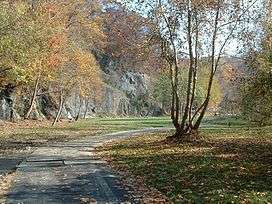
The Delaware Distance Classic is a 15K road race held in October by the Pike Creek Valley Running Club (PCVRC). The course has rotated every few years based on sponsorship and is currently located in nearby Delaware City. The event began in 1983 as a fundraiser for the PCVRC, and the Mike Clark Legacy Foundation has been the beneficiary for the last few years.
The Caesar Rodney Half Marathon is a 21.0975-kilometre (13.1094 mi) road race held annually since 1964 on the second Sunday in March.[90] Billed by race organizers as the "granddaddy of Delaware road races," it generally draws more than 1,000 runners from 20 states and several countries. From the starting line at Wilmington's Rodney Square, runners flow past the scenic revitalized riverfront, through Rockford Park and back to Rodney Square at the Caesar Rodney statue. Proceeds benefit the American Lung Association of Delaware.[91]
The Run for the Buds 1/2 Marathon, 1/2 Marathon Relay, and 5K Run/Walk is held annually at Rockford Park in mid-October. Proceeds benefit people with intellectual disabilities through the Down Syndrome Association of Delaware.[92]
Cycling
The Wilmington Grand Prix is held annually and is considered one of the premier criterium-style bike races in the country. Now in its 11th year, it is part of USA Cycling's National Race Calendar, a collection of only the most elite races. Weekend festivities include a street festival, a time trial on Monkey Hill, criterium races in downtown Wilmington at both the amateur and pro level, a 50 km (31 mi) Media Fondo, a 100 km (62 mi) Gran Fondo, and a leisurely Governor's Ride.[93]
Additionally, the East Coast Greenway passes through Wilmington and its immediate suburbs for 10.4 miles as part of the scenic Northern Delaware Greenway, which includes steep hills, heavily forested sections and paved portions that lead through downtown.[94][95]
Education
Wilmington is served by the Brandywine, Christina, and Red Clay school districts for elementary, junior high, and high school public education. The New Castle County Vocational-Technical School District operates Howard High School of Technology in the city of Wilmington.
In 1954, the Brown v. Board of Education decision by the U.S. Supreme Court forced the then segregated schools of New Castle County to desegregate. However, the subsequent eleven school districts that were created in the county, including the Wilmington School District, soon became de facto segregated, as the Wilmington School District became predominately black, and the districts outside the city remained overwhelmingly white. In response, the 1976 U.S. District Court decision Evans v. Buchanan implemented a plan by which students in Wilmington would be bused to attend school in the suburbs for certain grades, while suburban students would be bused into the City of Wilmington for other grades. By 1981, the four current districts in northern New Castle County, Brandywine, Christina, Colonial, and Red Clay, each composed of city and suburban areas, were established. However, Colonial School District no longer serves any portion of the city of Wilmington.
There are many private elementary and secondary schools in Wilmington:[96] Salesianum School, Serviam Girls Academy, Nativity Preparatory of Wilmington,[97] Ursuline Academy, Wilmington Friends School, The Tatnall School, Tower Hill School, St. Elizabeth High School, and Padua Academy. With 17.6% of its students enrolled in private schools, Wilmington ranks as one of the top ten cities in the country.[98]
Wilmington also hosts two charter schools, including the Charter School of Wilmington, and East Side Charter School, and a magnet school, Cab Calloway School of the Arts which focuses on the performing arts. The Charter School of Wilmington and Cab Calloway School of the Arts are housed in the building of the former Wilmington High School.
Universities and colleges
There are several colleges operating in the city of Wilmington:
- Delaware College of Art & Design
- Delaware Technical & Community College – Wilmington Campus
- Dawn Career Institute
- Drexel University – Wilmington Campus
- Springfield College – Wilmington Campus
- University of Delaware – Wilmington Campus and Downtown Building
Points of interest
| New Netherland series |
|---|
| Exploration |
| Fortifications: |
| Settlements: |
| The Patroon System |
|
| People of New Netherland |
| Flushing Remonstrance |
 |
- Brandywine Zoo[99]
- Delaware Art Museum
- Delaware Center for the Contemporary Arts[100]
- Delaware Center for Horticulture
- Delaware Children's Museum
- Delaware Children's Theatre
- Delaware Historical Society
- Delaware Sports Museum and Hall of Fame
- Delaware Theatre Company[101]
- DuPont Playhouse
- Frank Furness Railroad District, a collection of railroad buildings designed by Frank Furness
- Fort Christina State Park
- Grand Opera House
- Kalmar Nyckel Foundation & Tall Ship
- Holy Trinity (Old Swedes') Church
- Riverfront Market
- Rockford Tower
- Rodney Square
- Wilmington Blue Rocks, Carolina League baseball
- Wilmington Drama League Wilmington, Delaware[102]
- The Wilmington Library[103]
- Wilmington Riverfront
- Wilmington State Parks which includes Brandywine Park[104]
Near the city
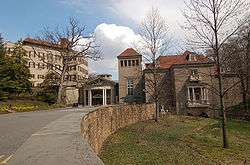
- Cooch's Bridge
- Delaware Museum of Natural History
- Hagley Museum and Library
- Mount Cuba Center
- Nemours Mansion and Gardens
- Winterthur Museum and Country Estate
- Longwood Gardens
- Brandywine Battlefield
- Brandywine River Museum
- Christiana Mall
Sister cities
Wilmington has six sister cities, as designated by Sister Cities International: [105]
-
 Fulda, Hesse, Germany
Fulda, Hesse, Germany -
 Kalmar, Sweden
Kalmar, Sweden -
 Olevano sul Tusciano, Salerno, Campania, Italy
Olevano sul Tusciano, Salerno, Campania, Italy -
 Osogbo, Nigeria
Osogbo, Nigeria -
 Watford, Hertfordshire, England, United Kingdom
Watford, Hertfordshire, England, United Kingdom
Partner city
-
 Nemours, Seine-et-Marne, Île-de-France, France
Nemours, Seine-et-Marne, Île-de-France, France
See also
- List of people from Wilmington, Delaware
- List of Wilmington Mayors
- National Register of Historic Places listings in Wilmington, Delaware
- Sunday Breakfast Mission
- List of tallest buildings in Wilmington, Delaware
References
- ↑ Min, Shirley (December 7, 2012). "New signs welcome folks to Delaware's largest city". WHYY-FM News. Retrieved 2016-03-17.
- ↑ "2016 U.S. Gazetteer Files". United States Census Bureau. Retrieved Jul 25, 2017.
- 1 2 "Population and Housing Unit Estimates". Retrieved June 9, 2017.
- ↑ "Estimates of Resident Population Change and Rankings: July 1, 2014 to July 1, 2015 - United States -- Metropolitan Statistical Area; and for Puerto Rico". U.S. Census Bureau. Retrieved January 9, 2017.
- ↑ "Wilmington". Geographic Names Information System. United States Geological Survey.
- ↑ "Lenape Talking Dictionary". Retrieved May 27, 2012.
- ↑ "Quickfacts Wilmington city, Delaware". US Census Population Estimates Program. July 1, 2015. Retrieved Dec 16, 2016.
- ↑ https://factfinder.census.gov/faces/tableservices/jsf/pages/productview.xhtml?src=bkmk
- ↑ "Table 1. Annual Estimates of the Population of Metropolitan and Micropolitan Statistical Areas: April 1, 2010 to July 1, 2015" (CSV). 2015 Population Estimates. United States Census Bureau, Population Division. March 2016. Retrieved Dec 16, 2016.
- ↑ "Annual Estimates of the Resident Population: April 1, 2010 to July 1, 2015 - United States -- Combined Statistical Area; and for Puerto Rico". United States Census Bureau, Population Division. March 2016. Archived from the original on August 15, 2014. Retrieved Dec 16, 2016.
- ↑ https://www.geni.com/projects/Svenska-pr%25C3%25A4ster-genom-tiderna/11253
- ↑ Munroe, John A. (1978), Colonial Delaware: A History, A History of the American colonies, Millwood, New York: KTO Press, p. 16, ISBN 978-0-527-18711-8, OCLC 3933326
- ↑ McCormick, Richard P. (1964), New Jersey from Colony to State, 1609–1789, New Jersey Historical Series, Volume 1, Princeton, New Jersey: D. Van Nostrand Co., p. 12, OCLC 477450
- ↑ Scharf, J. Thomas (1888), "XXIV. Medicine and medical men", History of Delaware, 1609–1888 (Google-digitized page images), Volume 1, Hathi Trust, p. 471, OCLC 454559306, LCCN 01013423, retrieved May 14, 2011 Original publisher was L. J. Richards: Philadelphia.
- ↑ Stidham, Jack (2001), "The descendants of Dr. Timothy Stidham" (PDF), Swedish Colonial News, Philadelphia, Pennsylvania: The Swedish Colonial Society, 2 (5), p. 16, OCLC 37868632, archived (PDF) from the original on May 15, 2011, retrieved May 14, 2011
- ↑ Munroe, John A. (2006), "The Lower Counties on the Delaware", History of Delaware (5th ed.), Newark, Delaware: University of Delaware Press, p. 57, ISBN 0-87413-947-3, OCLC 68472272,
Originally, the new community was called Willingtown, after Thomas Willing, an English merchant who settled there and began selling town lots in 1731 after marrying the daughter of a Swedish landowner, Andrew Justison
- ↑ Justison, Willing's father-in-law, purchased the land from the family of Samuel Peterson.
- ↑ Ferris, Benjamin (1846). "Part III. Chapter II. History of Wilmington". A History of the Original Settlements on the Delaware from its Discovery by Hudson to the Colonization under William Penn (eBook). Wilmington, Delaware: Wilson & Heald (eBook: The Darlington Digital Library). p. 202. OCLC 124509564.
- ↑ "First Powder Mill: 1802". DuPont home, English-US version. Wilmington, Delaware: DuPont. Retrieved January 9, 2010. Archive attempt via WebCitation.org failed May 14, 2011.
- ↑ "The DuPont Company". Delaware History Online Encyclopedia. Wilmington, Delaware: Delaware Historical Society. Archived from the original on May 15, 2011. Retrieved January 9, 2010.
- ↑ Boyer, William W. (2000), "Chapter Three: The Governor as Leader", Governing Delaware: Policy Problems In The First State (eBook), Newark, Delaware: University of Delaware Press (eBook: Google), p. 57, ISBN 0-87413-721-7, OCLC 609154858, retrieved May 14, 2011
- ↑ "NowData – NOAA Online Weather Data". National Oceanic and Atmospheric Administration. Retrieved 2016-04-13.
- ↑ "Station Name: DE WILMINGTON NEW CASTLE CO AP". National Oceanic and Atmospheric Administration. Retrieved 2014-05-05.
- ↑ "Census of Population and Housing". Census.gov. Archived from the original on May 12, 2015. Retrieved June 4, 2015.
- ↑ "Population Estimates". United States Census Bureau. Archived from the original on October 19, 2016. Retrieved July 15, 2016.
- ↑ "Wilmington (city), Delaware". State & County QuickFacts. U.S. Census Bureau. Retrieved May 14, 2012.
- ↑ "Delaware – Race and Hispanic Origin for Selected Cities and Other Places: Earliest Census to 1990". U.S. Census Bureau. Archived from the original on August 6, 2012. Retrieved May 14, 2012.
- ↑ "2010 SF1 Data for Wilmington, Delaware". City-Data. U.S. Census Bureau. Archived from the original on March 5, 2014. Retrieved November 17, 2011.
- ↑ "2010 SF1 Data for Wilmington, Delaware". City-Data. U.S. Census Bureau. Retrieved November 17, 2011.
- ↑ http://www.delawareonline.com/story/news/2016/12/29/wilmington-mayor-city-council-inaguration-tuesday/95952616/
- ↑ "Howard R. Young Correctional Institution". Delaware Department of Correction. State of Delaware. August 18, 2010. Archived from the original on August 18, 2010. Retrieved August 30, 2010.
- ↑ Chalmers, Mike (May 14, 2011). "Unions' pact with Wilmington saves 235 jobs". The News Journal. New Castle, Delaware: Gannett. DelawareOnline. Archived from the original on May 14, 2011. Retrieved May 14, 2011.
- ↑ "Wilmington Neighborhoods" (PDF). City of Wilmington, Delaware. February 14, 2005. Archived (PDF) from the original on June 8, 2010.
- ↑ "Brandywine Hills". Neighborhood Link. September 22, 2010. Archived from the original on May 18, 2011. Retrieved October 9, 2010.
- ↑ "Greater Brandywine Village". Greater Brandywine Village. Archived from the original on May 18, 2011. Retrieved October 9, 2010.
- ↑ "The Triangle Neighborhood Association". Wilmington, Delaware. 2009. Archived from the original on March 9, 2009.
- ↑ "Midtown Brandywine Neighbors Association". Neighborhood Link. Archived from the original on May 18, 2011. Retrieved October 9, 2010.
- ↑ "Quaker Hill Historic Preservation Foundation". Quaker Hill Historic Preservation Foundation. Archived from the original on October 8, 2009. Retrieved October 9, 2010.
- ↑ "Wilmington Monthly Meeting of Friends". Wilmington Friends Meeting. Archived from the original on April 18, 2009. Retrieved October 9, 2010.
- ↑ "Riverfront Wilmington". Riverfront Development Corporation. June 26, 2010. Archived from the original on February 21, 2009. Retrieved October 9, 2010.
- ↑ "Trinity Vicinity.org Website". Trinity Vicinity Neighborhood Association. Archived from the original on October 15, 2008. Retrieved October 9, 2010.
- ↑ "11th Street Bridge Civic Association". Neighborhood Link. Archived from the original on May 19, 2011. Retrieved May 18, 2011.
- ↑ "Hedgeville Community Association". Neighborhood Link. Archived from the original on May 19, 2011. Retrieved October 9, 2010.
- ↑ "Co-ed and Single Sex". Ursuline Academy. Retrieved July 19, 2012.
- ↑ "Padua Academy: About Us". Padua Academy. Retrieved July 19, 2012.
- ↑ "Neighborhoodlink.com". Neighborhood Link. Archived from the original on July 14, 2011. Retrieved October 9, 2010.
- ↑ Staub, Andrew (August 17, 2013). "After demolition, a neighborhood reborn". The News Journal. Wilmington, Delaware.
- ↑ "Forty Acres Civic Association". Neighborhood Link. Archived from the original on May 19, 2011. Retrieved May 18, 2011.
- ↑ "Hilltop Neighborhood Working Group". Community Services: Neighborhoods. City of Wilmington. Archived from the original on June 28, 2009. Retrieved October 9, 2010.
- ↑ "Welcome to Little Italy". Little Italy Neighborhood Association. Archived from the original on June 8, 2009. Retrieved October 9, 2010.
- ↑ "Trolley Square Delaware Shopping, Activities, Events". Trolley Square Merchant Association. Archived from the original on May 9, 2009. Retrieved October 9, 2010.
- ↑ "Wawaset Park Maintenance Corp.". Neighborhood Link. Archived from the original on May 19, 2011. Retrieved October 9, 2010.
- ↑ "Union Park Gardens". Neighborhood Link. Archived from the original on May 19, 2011. Retrieved October 9, 2010.
- ↑ "City Historic Districts". Community Services. City of Wilmington. Archived from the original on January 25, 2009. Retrieved October 9, 2010.
- ↑ "(title not known)". Archived from the original on August 20, 2014. Page not found in archive.org.
- ↑ Parra, Estaban (April 30, 2011), "Taking Change Beyond Talk", The News Journal, New Castle, Delaware: Gannett, archived from the original on May 20, 2011, retrieved April 30, 2011 Only the first of two web pages is archived.
- ↑ "Top Ten Most Dangerous Cities in America". Parenting. Retrieved August 24, 2012.
- ↑ Brown, Robin (December 10, 2013). "Wilmington's 22nd shooting death adds to gun fears". The News Journal. Wilmington, Delaware. Retrieved 2013-12-12.
- ↑ "Wilmington, DE Auto Theft Statistics".
- ↑ "10 Most Dangerous Small Cities in America – Movoto". Movoto Blog.
- ↑ "Murder Town USA (aka Wilmington, Delaware)". Newsweek. December 9, 2014. Retrieved 2014-12-11.
- ↑ "Department of Police". City of Wilmington. Retrieved December 14, 2013.
- ↑ "Future Crimes Database Set Up By Delaware Police". News Alerts. Stephen Quayle. Archived from the original on December 15, 2006. Retrieved October 30, 2009. The referenced page purports to be an online reprint of an article from The News Journal by Adam Taylor dated August 25, 2002. This remains to be verified.
- ↑ Taylor, Adam (November 19, 2002). "Wilmington, Delaware gets more surveillance cameras". Infoshop News. Retrieved December 21, 2010. Attempt to archive using WebCitation.org encountered a no-cache tag; not found in archive.org.
- ↑ "2006–2008 Statewide Coordinated Statement of Need & Comprehensive Treatment Plan" (PDF). State of Delaware. Archived from the original (PDF) on March 26, 2009. Retrieved October 30, 2009.
- ↑ Centers for Disease Control and Prevention (June 2007), "Cases of HIV infection and AIDS in the United States and Dependent Areas, 2005" (PDF), HIV/AIDS Surveillance Report, Atlanta, Georgia: United States Department of Health and Human Services, 17, archived from the original (PDF) on September 27, 2009, retrieved October 30, 2009
- ↑ "Delaware: Legislature Finally OKs Needle Exchange Program". CDC HIV/Hepatitis/STD/TB Prevention News Update. New York City: The HealthCentral Network. June 30, 2006. Archived from the original on May 20, 2011. Retrieved October 30, 2009.
Adapted from:News Journal 06.30.2006; Cris Barrish
- ↑ Taylor, Adam (April 3, 2010), "Delaware transportation: For now, it's a headache on all sides of the tracks", The News Journal (delawareonline), New Castle, Delaware: Gannett, (Subscription required (help))
- ↑ "(Unknown)". Baltimoresun.com. June 2, 2009. Archived from the original on June 4, 2011. Retrieved October 9, 2010.
- ↑ "Fortune 500 2012: Delaware". CNN. May 21, 2012. Retrieved July 18, 2012.
- ↑ "Lawsuit Climate: 2010". instituteforlegalreform.com. Washington, D.C.: Institute for Legal Reform. Archived from the original on May 29, 2011.
- ↑ "CELEBRATING THE TRADITION OF EXCELLENCE – COURTS AND COURTHOUSES" (PDF). Retrieved 16 February 2016.
- ↑ "Frequently Asked Questions for the Board of Bar Examiners". Delaware Judiciary. Archived from the original on August 26, 2010. Retrieved October 9, 2010.
- ↑ "City of Wilmington CAFR" (PDF). p. 160. Retrieved July 15, 2016.
- ↑ http://auditor.delaware.gov/Reports/FY2015/FY%202014%20CAFR.pdf
- ↑ "Financial Reports :: Government :: City of Wilmington, Delaware". wilmington.de.us.
- ↑ Shearer, Barbara Smith (2002). State names, seals, flags, and symbols. Greenwood Publishing Group. p. 258. ISBN 0-313-31534-5.
- ↑ "Indiafest 2009". IAAD- Indo American Association of Delaware. Retrieved December 1, 2009.
- ↑ staff (Dec 3, 2011), "O christmas tree", The News Journal (Delaware Online ed.), retrieved December 3, 2011
- ↑ "History of the Delaware Theatre Company". Delaware Theatre Company. Retrieved January 2, 2013.
- ↑ "Circulation". delawareonline. Gannett. February 14, 2008. Archived from the original on June 8, 2011. Retrieved June 7, 2011.
Source: ABC Audit Report, 12/26/04
- ↑ "Top 100 US Daily Newspaper" (PDF). BurellesLuce. 2007. Archived from the original (PDF) on March 25, 2009. Retrieved June 7, 2011.
Source: Audit Bureau of Circulations figures for six-month period ending 3.31.07
- ↑ "Delaware Newspapers". Delaware Library. Retrieved 8 December 2013.
- ↑ Mullinax, Gary (October 31, 2003). "TV version of God hanging out in Wilmington". The News Journal. Wilmington, Delaware: Gannett Corporation. pp. A1. Retrieved July 8, 2010.(subscription required)
- ↑ "Cold Opening: Obama visits Biden". Saturday Night Live. Hulu. May 12, 2012. Retrieved July 18, 2012.
- ↑ "New ABC drama 'Murder Town' set in Wilmington". USA TODAY. Retrieved 2016-02-06.
- ↑ http://www.delawareonline.com/story/entertainment/2016/08/12/murder-town-tv-show-probably-dead-point/88614690/
- ↑ Bob Hille, Matt Crossman. "Best Sports City 2010". Sportingnews.com. Retrieved August 20, 2011.
- ↑ "Wilmington State Parks". Delaware Department of Natural Resources and Environmental Control. Retrieved September 27, 2007.
- ↑ "American Lung Association – Event Information". Mrsnv.com. Retrieved October 9, 2010.
- ↑ "2014 Caesar Rodney Half Marathon & 5K – Wilmington, DE – American Lung Association – Events". lung.org.
- ↑ "DSA Delaware". Run for the Buds. Retrieved July 18, 2012.
- ↑ http://wilmgrandprix.com/about/
- ↑ http://delawaregreenways.org/portfolio_page/northern-delaware-greenway-trail/
- ↑ http://www.greenway.org/explore-by-state/de
- ↑ "New Castle County, DE Private Schools - PrivateSchoolReview.com". privateschoolreview.com.
- ↑ "Nativity Preparatory School of Wilmington". Nativity Preparatory School of Wilmington.
- ↑ Jacob Davidson. "You'll Never Guess the City Where Private School Is Most Common – TIME". MONEY.com.
- ↑ "Brandywine Zoo". Brandywine Zoo. Retrieved October 9, 2010.
- ↑ "Delaware Center for the Contemporary Arts". Thedcca.org. Retrieved October 9, 2010.
- ↑ "Delaware Theatre Company". Delawaretheatre.org. Retrieved October 9, 2010.
- ↑ "Wilmington Drama League". Wilmingtondramaleague.org. December 13, 2011.
- ↑ "Wilmington Public Library". Wilmlib.org. October 5, 2010. Retrieved October 10, 2010.
- ↑ "Friends of Wilmington Parks". Brandywinepark.org. Retrieved October 9, 2010.
- ↑ "Sister Cities of Wilmington website". Sistercitieswilmington.org. Retrieved October 9, 2010.
Further reading
- Published in the 18th and 19th centuries
- Jedidiah Morse (1797). "Wilmington". The American Gazetteer. Boston, Massachusetts: At the presses of S. Hall, and Thomas & Andrews.
- Charles P. Dare (1877), "Wilmington", Philadelphia, Wilmington and Baltimore Railroad guide book, OCLC 37266637
- Published in the 20th century
- Carol Hoffecker: Corporate Capital: Wilmington in the Twentieth Century, Philadelphia: Temple University Press, 1983
External links
| Wikimedia Commons has media related to Wilmington, Delaware. |
| Wikivoyage has a travel guide for Wilmington (Delaware). |
| Wikisource has the text of an 1879 American Cyclopædia article about Wilmington, Delaware. |
- Wilmington, Delaware
- Downtown Wilmington
- Wilmington Riverfront
- Wilmington Visitors Bureau
- Historic Wilmington Archive
- Swedish Colonial Society
- Wilmington Riverfront Hazy Summer morning – Photograph published in the News Journal
- Wilmington Riverfront Cranes at Night
- Condos at the Riverfront
- Photo St. Anthony's Festival
-
 "Wilmington, a city, a port of entry and the county-seat of New Castle county, Delaware, U.S.A.". Encyclopædia Britannica (11th ed.). 1911.
"Wilmington, a city, a port of entry and the county-seat of New Castle county, Delaware, U.S.A.". Encyclopædia Britannica (11th ed.). 1911.
